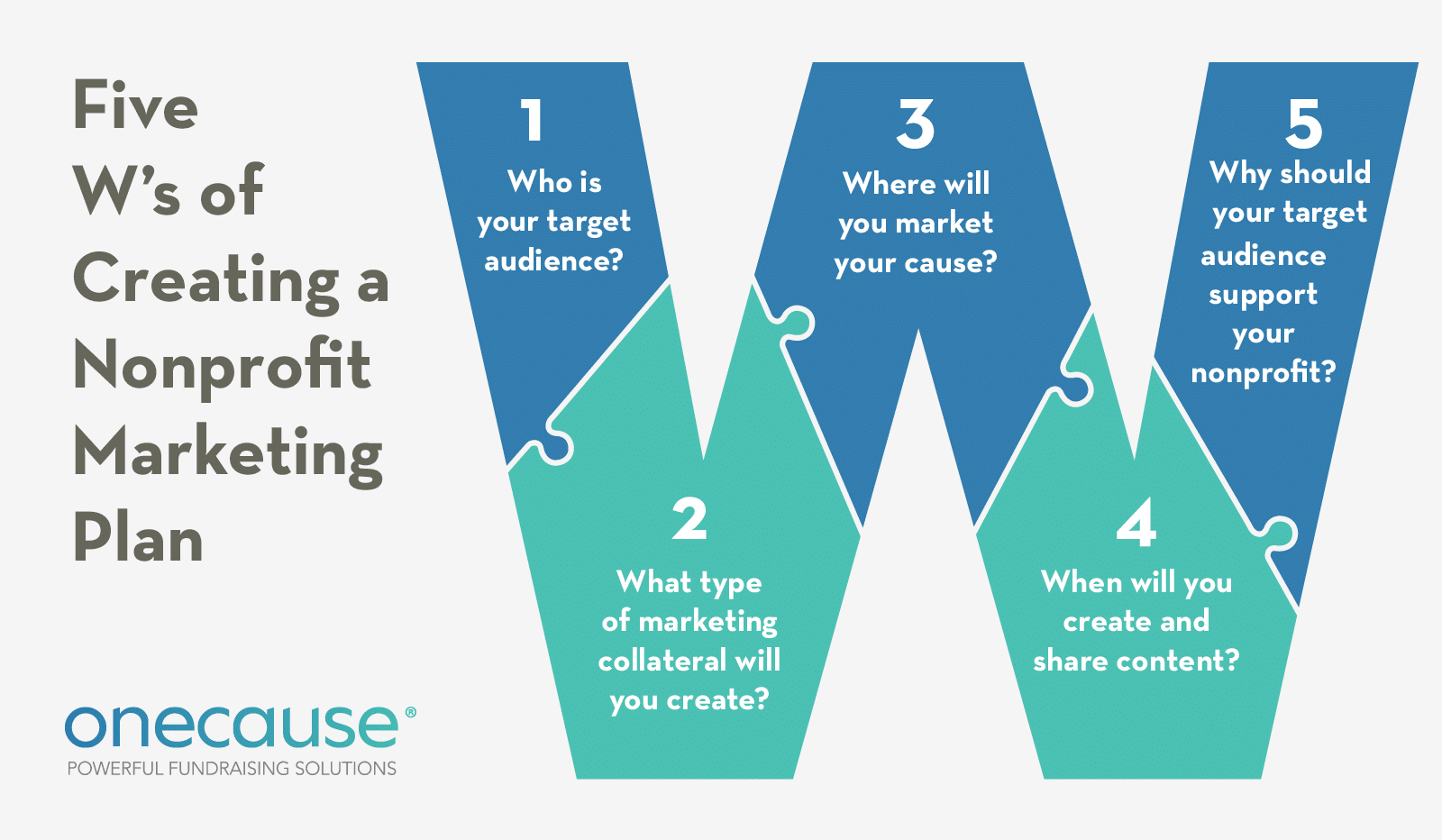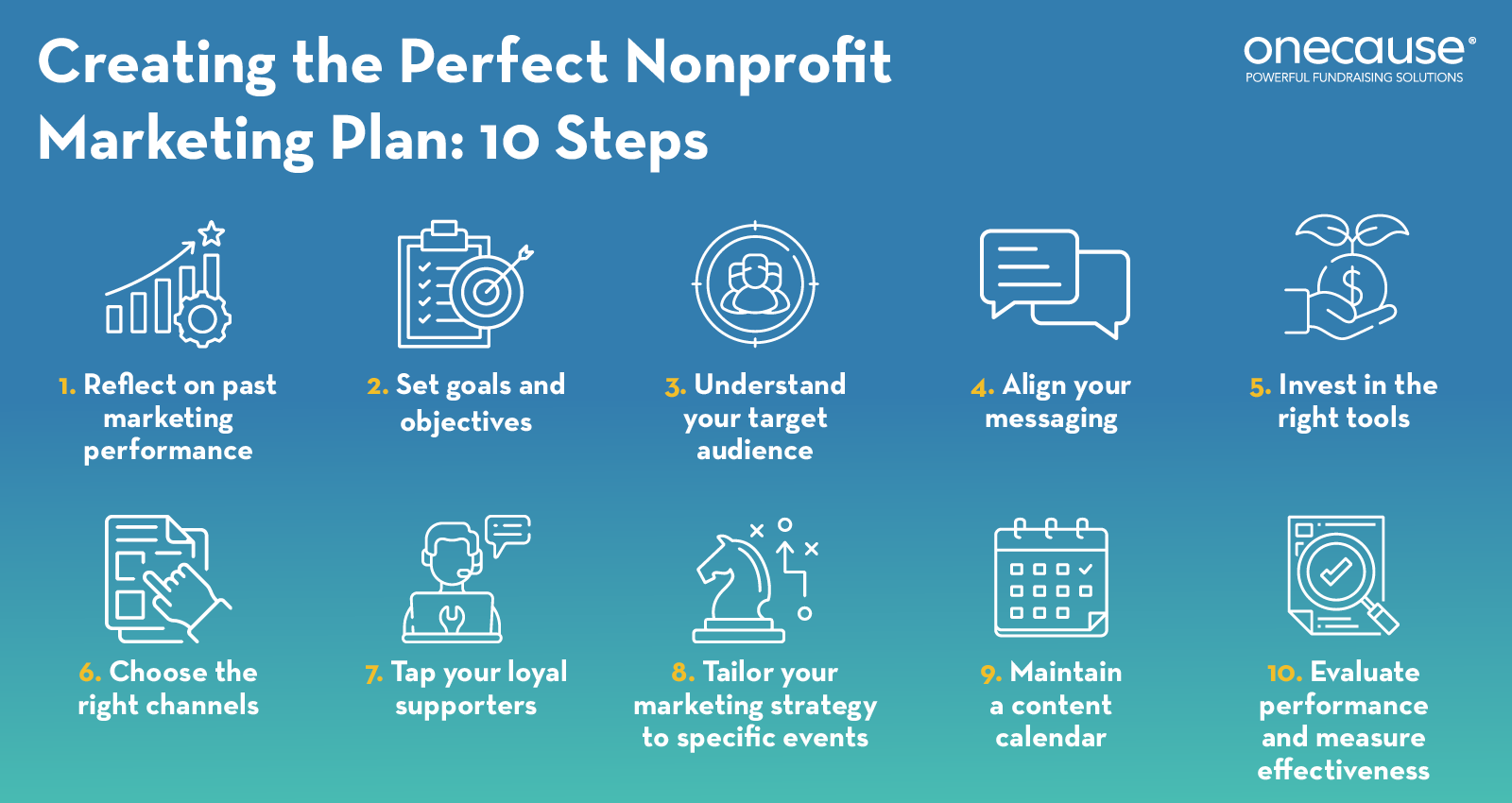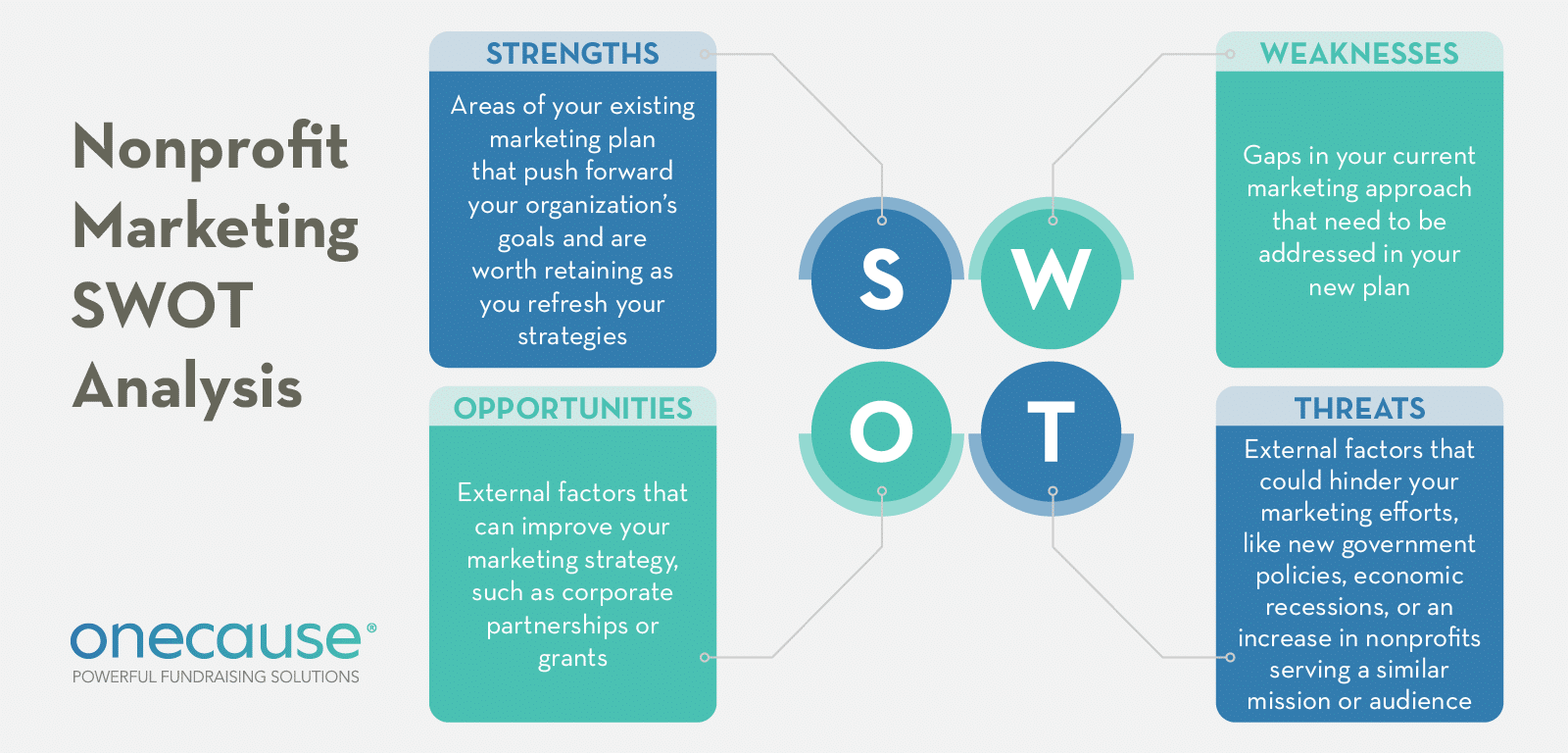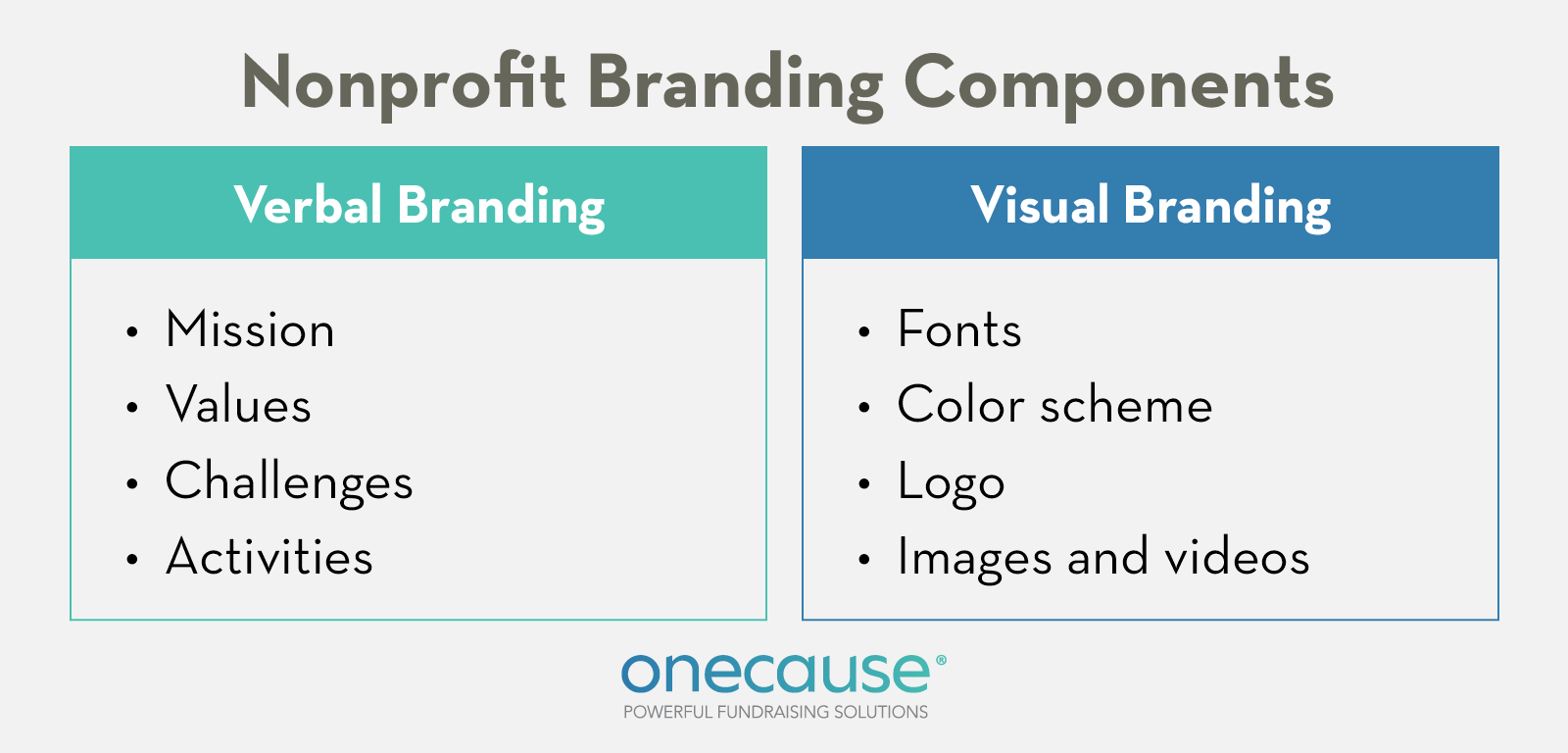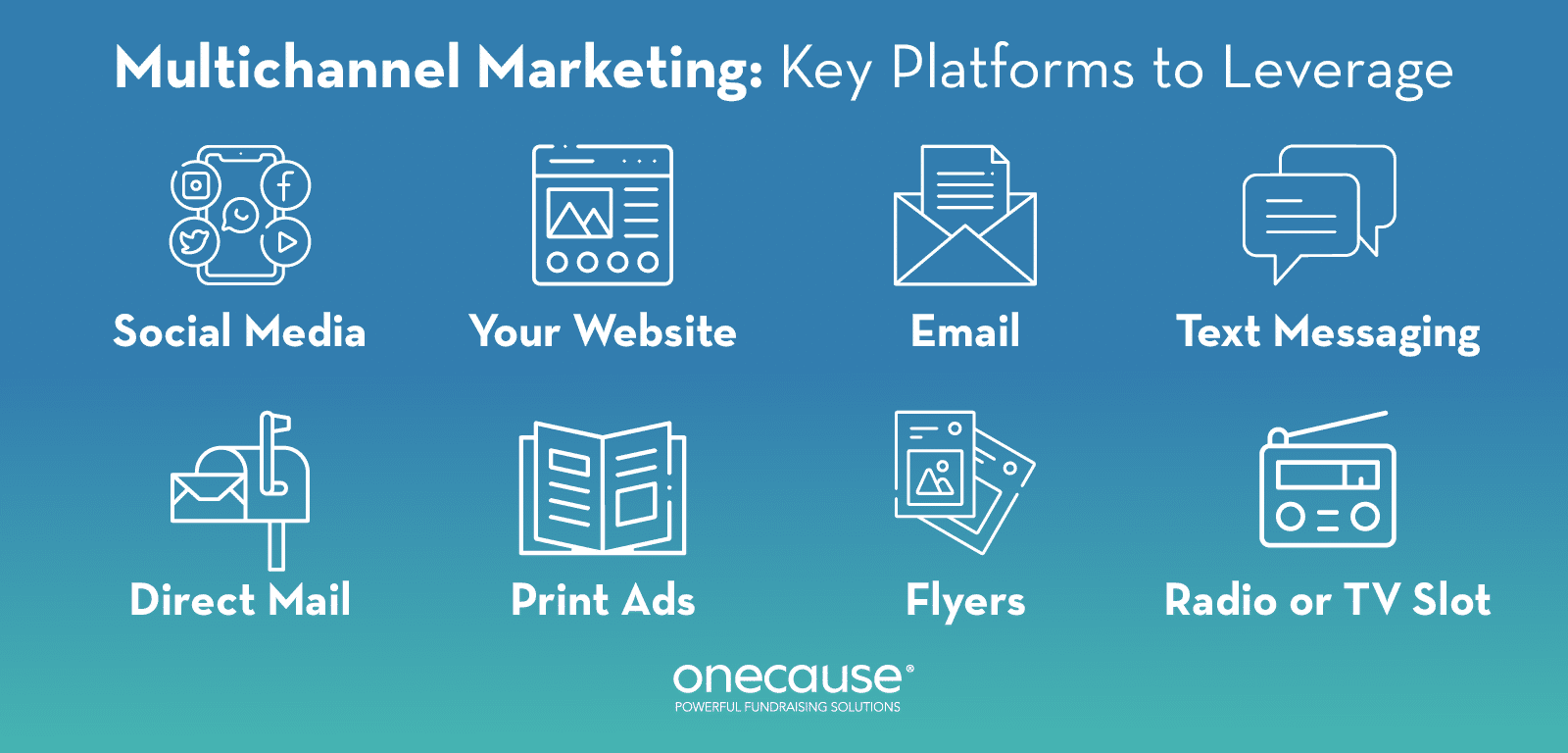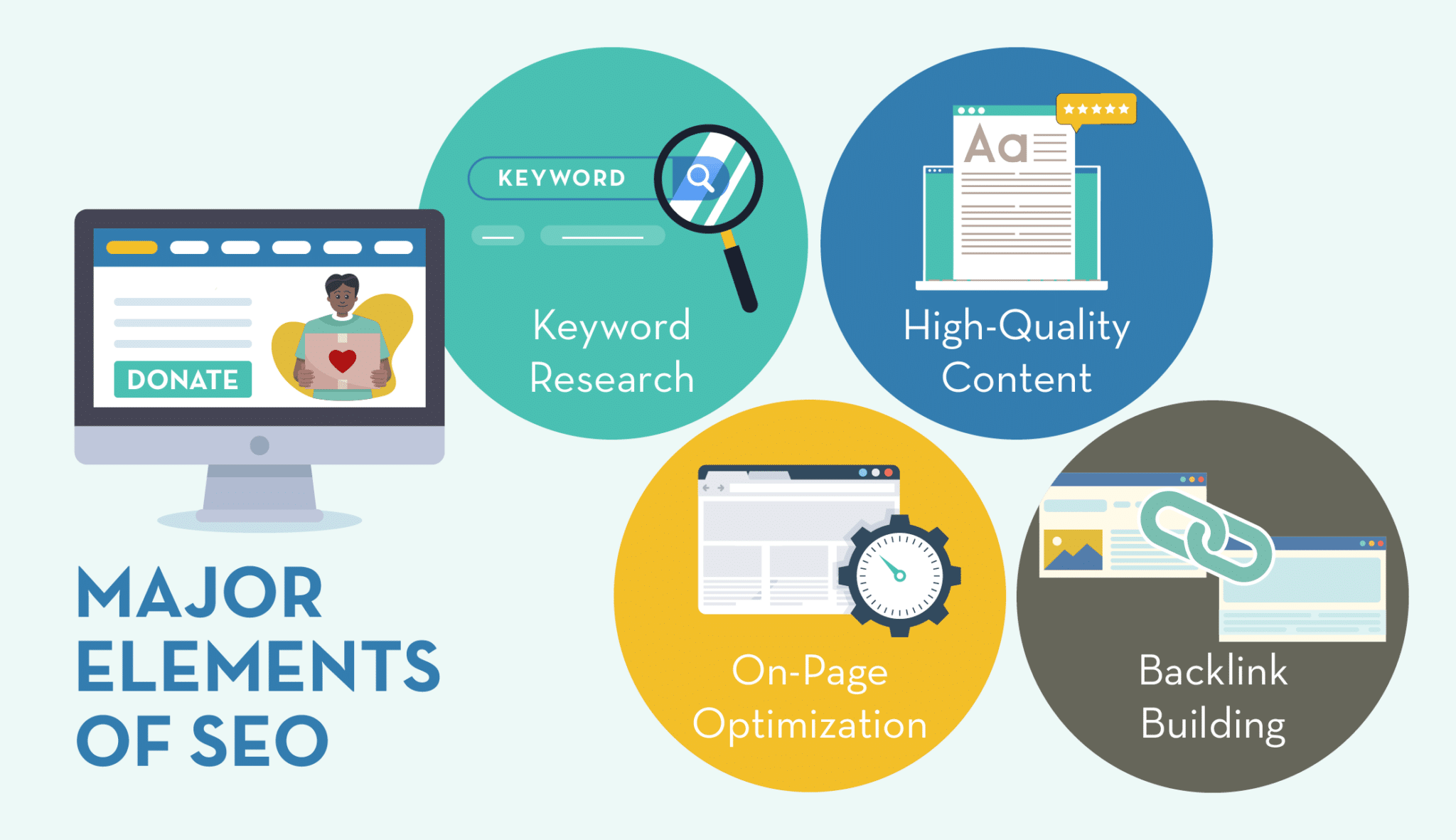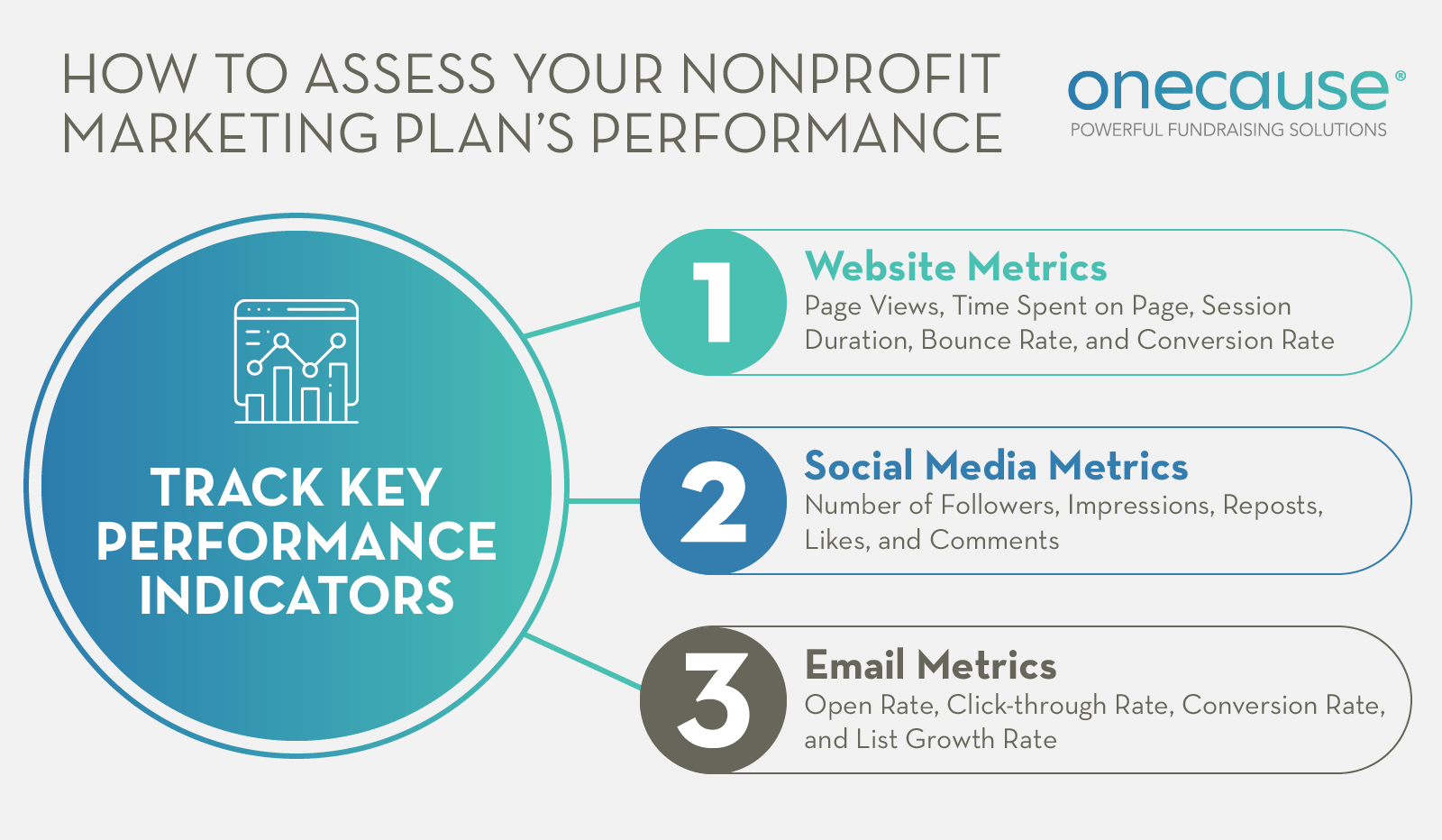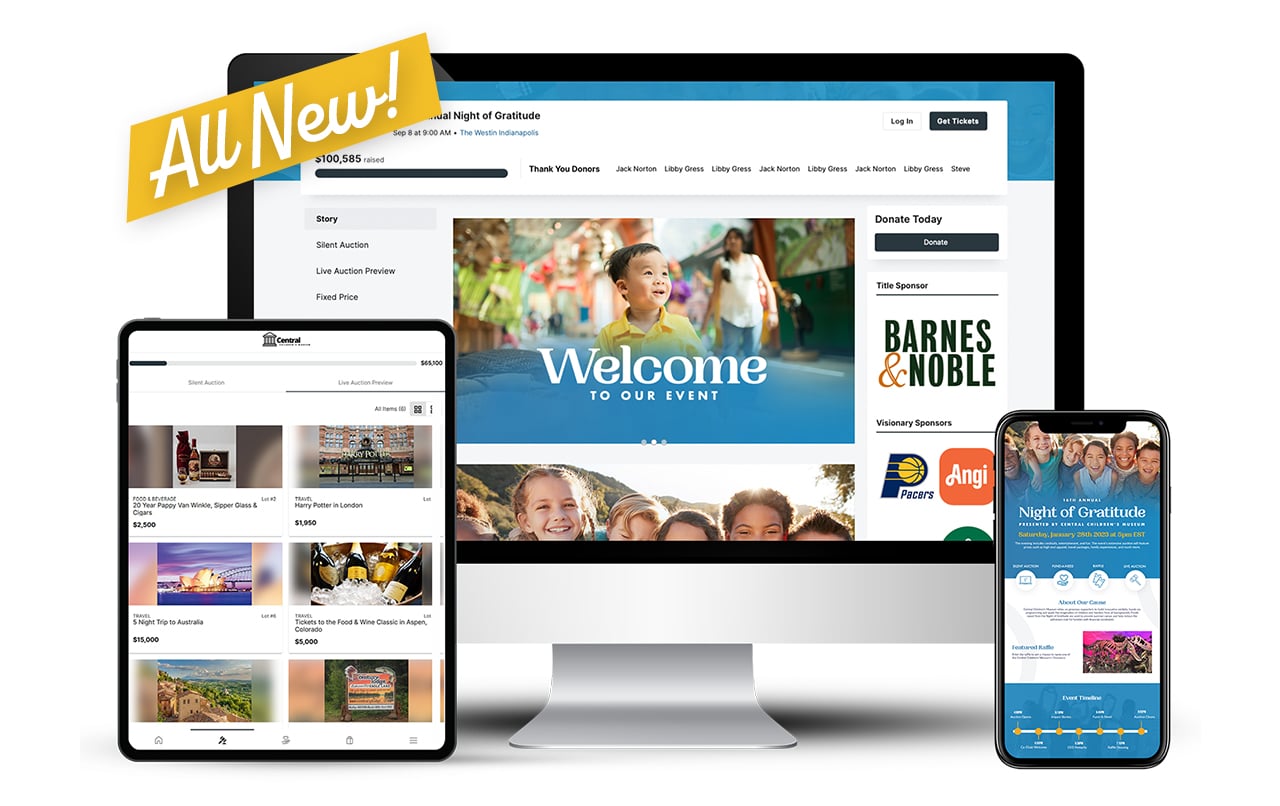A Complete Guide to Creating a Nonprofit Marketing Plan
Getting the word out about your nonprofit’s services, campaigns, and events is critical to your mission’s success. With so many resources at your fingertips—from digital platforms like social media to more traditional advertising opportunities like direct mail—your organization has several options to communicate your mission and build support for your cause.
However, creating a strong marketing plan isn’t based on the quantity of how many platforms you use or the number of promotional messages you share; instead, it’s the quality of your marketing approach that counts and ultimately determines your nonprofit’s success in amplifying its cause and growing a loyal donor base.
This is where taking the time to compose a strategic marketing plan can help. A marketing plan gives your nonprofit a clear framework for describing your mission, establishing your brand, and effectively reaching your target audience. With these guidelines, you can confidently approach any marketing campaign or fundraising event and expand your reach to supporters near and far.
In this guide, we’ll walk you through all the essentials you’ll need to create a marketing plan tailored to your nonprofit. We’ll cover:
Your nonprofit puts in a lot of hard work to bring its mission to life. Now, you just need the right marketing strategies and tools to connect donors to your cause and boost your support. Let’s begin!
Nonprofit Marketing Plan FAQs
Before we dive into how to create the perfect nonprofit marketing plan, let’s make sure we cover the basics. These common FAQs can help you understand how to construct a powerful marketing strategy.
What is a nonprofit marketing plan?
A nonprofit marketing plan outlines how your organization can bring attention to its cause, campaigns, and events with target donor segments, using various marketing channels. These guidelines will help your nonprofit through every step of its marketing approach, answering questions like:
- Who your target audience is
- What type of marketing collateral you’ll create
- Where you’ll market your cause (the online or in-print channels)
- When you’ll create and share content with a comprehensive calendar
- Why your target audience should support your nonprofit instead of another organization serving a similar purpose or audience
Creating a nonprofit marketing plan is a great opportunity for your entire team to reflect on your current marketing approach and how you can hone your strategy for increased engagement.
Once you compose your nonprofit marketing plan, your staff members and volunteers will have a trusted framework to guide their marketing and communication tactics. This ensures that all of your marketing activities are aligned and promote the same messaging and goals.
What are the benefits of a nonprofit marketing plan?
Creating a marketing plan for your nonprofit requires time and thoughtful consideration, but the benefits are well worth the effort. A cohesive marketing plan can:
- Raise awareness for your cause. Whether you’re hosting an awareness campaign or simply want people to learn more about your cause, a strong marketing strategy can educate your community about your nonprofit’s mission and increase exposure for your organization.
- Expand your reach. By leveraging a multichannel marketing strategy focused on reaching your target audience, your nonprofit can introduce new donors to your cause and direct them to your donation page.
- Build strong donor relationships. Donor stewardship requires consistent engagement and multiple touchpoints. A well-designed marketing plan keeps existing donors up to date on your projects and services, reminding them why they should continue to support your organization.
- Strengthen your digital presence. A strong digital presence communicates professionalism and trustworthiness to your supporters, increasing the likelihood that they’ll want to deepen their involvement with your nonprofit.
- Highlight upcoming events. Increasing registration numbers for your fundraising events and meeting your event revenue goals are central objectives. A nonprofit marketing plan provides the guidance needed to nail down event messaging and target the right people on the right platforms.
Attract new volunteers. Your nonprofit relies on volunteers to carry out important programs, services, and projects. Advertising your volunteer program boosts sign-ups and helps you build a loyal volunteer base. - Increase service and program revenue. A strategic nonprofit marketing plan can bring attention to the services, programs, and products you sell, such as trainings, curriculum, or event registrations. By integrating search engine optimization (SEO) into your strategy in particular, your nonprofit can attract more visitors to key pages on your site and inspire them to purchase your offerings.
Think of your nonprofit marketing plan as a roadmap for all communications. A thorough plan will give your team the clarity and organization needed to lead any marketing campaign on any channel and produce outstanding engagement results. Revisiting your plan once a year makes it easier for your team to make necessary adjustments, ensuring the document serves as your sole source of truth for communicating your brand and mission.
With a well-crafted marketing plan, your nonprofit is well-equipped to achieve its goals and make a lasting impact.
What are the key components of a nonprofit marketing plan?
A detailed nonprofit marketing plan is the cornerstone of successful outreach, enabling you to effectively promote your events, campaigns, volunteer programs, and more. Here’s how to ensure your plan covers all the bases:
- Messaging and positioning. Clearly articulate your mission statement and craft compelling messaging that resonates with your audience. Consistency across all marketing materials builds trust and ensures your supporters have a clear understanding of your values and impact.
- Brand guidelines. Define your brand identity through verbal elements (like messaging and tone) and through visual elements (like your logo, fonts, color scheme, and overall theme). A unified visual presence enhances brand visibility and fosters stronger connections with donors.
- Audience overview. Identifying your target audience is crucial for choosing the right channels and generating attention-grabbing content. To tailor your approach, determine your audience’s age range, interests, preferred channels, and giving habits. Then, you can create audience personas for different types of supporters you’ll market to, such as donors, volunteers, and beneficiaries.
- Digital marketing strategies. Amplify your nonprofit’s digital footprint by outlining comprehensive strategies, such as SEO to improve your website’s rankings on search engines, email marketing to keep your supporters informed, content marketing to provide insightful information, online advertising to drive actions like donating, and social media marketing to engage your community on their favorite platforms. Assign dedicated staff or volunteers to manage these channels.
- In-print marketing strategies. Don’t overlook the power of traditional in-print marketing, especially for reaching audiences who may not be as active online. Develop a strategy that includes targeted print channels and integrates seamlessly with your digital efforts. For instance, promote the virtual aspect of a hybrid auction online while sending personalized, handwritten invitations to major donors for the in-person component.
Focus on your organization’s goals and target audience as you map out each component of your plan. Investing time now to create a cohesive marketing plan will pay off in the long run, so collaborate with your team to craft a winning strategy that makes sense for your nonprofit.
How to Create a Nonprofit Marketing Plan: Top 10 Steps
To create the strongest marketing results for your organization, you need to consider how to best use the team members, tools, and resources at your disposal to optimize your outreach. Follow these steps to construct the perfect marketing plan for attracting more attention and supporters to your mission.
1. Reflect on past marketing performance.
Your nonprofit may already have a marketing strategy in place, but is it producing results? Conduct a SWOT analysis to identify what’s working and what’s not. A SWOT analysis allows your organization to outline its strengths, weaknesses, opportunities, and threats.
Let’s break down what a marketing SWOT analysis looks like:
- Strengths. Your nonprofit might be hitting your key performance indicators, sparking lively conversations on social media, or generating engaging blog content. Outline the areas of your existing marketing plan that push forward your organization’s goals and are worth retaining. Even your best strategies might still have room for improvement, so be open to ideating how you can hone your strengths for even better results.
- Weaknesses. Your weaknesses are gaps in your current marketing approach that need to be addressed in your new plan. For example, your nonprofit might struggle with driving engagement on your website or maybe you lack the staff and volunteer support needed to produce content on social media. By identifying the obstacles that are holding your nonprofit back, you can reallocate resources, increase your impact, and operate more effectively.
- Opportunities. From your weaknesses, you can pinpoint external opportunities to improve your marketing strategy and bolster your approach. For instance, if your nonprofit is struggling with marketing its events, you might begin forming corporate partnerships to expand your reach. Or, if you’ve identified gaps in your fundraising budget for marketing, you might apply for grants.
- Threats. Threats are external factors that could hinder your marketing efforts, like new government policies, economic recessions, or an increase in nonprofits serving a similar mission or audience (and therefore vying to attract your target supporters). While these aren’t in your control, you can proactively set up your nonprofit marketing plan to be flexible and adaptable.
Gather insights and opinions from a variety of stakeholders to determine how your marketing plan can improve. Your stakeholders might include:
- Marketing committee members
- Board members
- Staff
- Volunteers
- Major and long-time donors
Don’t just reach out to stakeholders that think highly of your organization. Critiques are invaluable, as these will point your organization in the direction of optimizing its approach. It’s important to be open to both positive and negative reviews to help your nonprofit’s marketing strategy become more effective.
2. Set goals and objectives.
Now that you’ve conducted a marketing audit and identified areas for improvement, it’s time to set concrete goals for your marketing strategy. Establishing clear, ambitious goals will enable your organization to grow and thrive over time.
However, it’s not enough to set broad goals like “We want to expand our social media presence” or “We’ll work on developing better event landing pages.” The more detailed you are in the goal-setting process, the more effective your organization will be in driving positive change.
This is where the SMART model comes into play. SMART goals are Specific, Measurable, Attainable, Relevant, and Time-bound, giving your organization a complete roadmap to how you’ll meet these goals and assess results.
Setting Goals For Email Marketing
Let’s say your nonprofit wants to improve its email marketing strategy. From your SWOT analysis, you found that your click-through rates are low and you’re sending out emails too erratically to inspire conversions.
Here’s how you could create a SMART goal to strengthen your email marketing:
- Specific: Our nonprofit will send out an email newsletter every week that covers upcoming projects and events, highlights progress from our latest fundraising campaign, and calls for donations and volunteer support.
- Measurable: Our goal is to increase our email click-through rate by 15%.
- Attainable: When we started including CTAs in our emails, our click-through rate improved by 5%. Therefore, a 15% boost in our click-through rate seems reasonable, especially since we’ll be sending emails regularly and providing more valuable content in them.
- Relevant: Increasing our email click-through rate will lead more supporters to our event landing pages, donation form, and other relevant resources. This will increase the likelihood of them participating in our campaigns or events, leading to higher engagement rates and stronger supporter relationships (plus more revenue to power our mission)!
- Time-bound: We will begin launching our new email newsletter strategy in one week and aim to achieve a 15% increase in average click-through rate in six months. We’ll plan to host a monthly meeting to check in on our progress and restrategize as needed.
Setting Goals For Boosting Event Attendance
Your fundraising events are a powerful source of revenue and help build community for your cause. If people don’t show up, you’re missing out on valuable face time with donors, volunteers, corporate sponsors, and other community members.
Here’s how you might set a SMART goal for event attendance that ensures your promotional efforts are targeted and effective:
- Specific: We will increase attendance at our annual fundraising gala through targeted social media ads, email invitations, and community partnerships.
- Measurable: Our goal is to increase attendance by 20% compared to last year.
- Attainable: Last year’s event had 200 attendees. With our improved marketing efforts, a 20% increase, equating to 240 attendees, is within reach.
- Relevant: Higher attendance at our fundraising gala will increase donations, boost community engagement, and enhance awareness of our cause.
- Time-bound: We will start our promotional campaign three months before the event and aim to achieve a 20% increase in attendees on the event day.
Takeaway: Following the SMART framework ensures you’re generating goals that are relevant to your marketing strategy and will expand your reach. You can also use them to foster accountability across your team, so identify the relevant people for each goal and ensure they’re aware of the timeline and success measurements.
3. Understand your target audience.
One of the best ways to nail down the details of your target audience is by developing a supporter persona. A supporter persona is a fictitious profile that outlines characteristics that are typical of your real-life supporters.
To craft a supporter persona, consider the following details:
- Age
- Income
- Geographic location
- Interests
- Causes they support
- Preferred communication methods
- Giving preferences
To develop your supporter persona, base these details off of a few real-life supporters. Ideally, you should create separate personas for your donors, volunteers, and other contributors. This way, you can adjust your messaging based on who you’re attempting to reach.
For example, if your organization is hosting a food drive, you’ll need to reach donors to help fund the cost of canned foods and give them to your organization as well as volunteers to help organize the cans and hand them out to individuals in need.
Once you know the different groups you’re targeting, you can send separate communications using segmentation features. You can even segment your email contacts list into different subgroups and tailor messages to the specific subsets of your audience.
4. Align your messaging.
Your messaging across different channels, from social media and email to your blog content, should be consistent. If the way you describe or visually portray your nonprofit changes from platform to platform, this can easily confuse supporters and lead to a decrease in trust. When shaping your messaging, it’s important to consider both your verbal and visual branding.
Verbal branding
Verbal branding is critical to building a strong relationship with your target audience. With your team, answer the following questions to inform your marketing communications:
- Mission. What is your core mission statement? What community does your organization serve? What ideal world are you striving to create? When discussing your organization’s purpose, the language and tone should be unified so supporters have a solid understanding of who your organization is and what you stand for.
- Values. What guiding principles define your organization and inform your operations? Values shape your organization’s culture, helping to rally your team around your cause and attract like-minded supporters. For example, your nonprofit might value compassion, empathy, and innovation.
- Challenges. What problems is your organization trying to solve? How will your projects and programs address these issues and create change? Prospective and new supporters might not have background knowledge of the issue that inspired your nonprofit’s founding, so avoid using technical language and clearly articulate the problem at hand.
- Activities. How is your organization working towards making your mission a reality? What programs, events, and activities will you lead to benefit your community and steward relationships with supporters? Answers to these questions will help donors and volunteers see the value in supporting your organization.
It’s equally important to consider not only what you say, but how you say it. Your organization might want to adopt a casual, friendly tone to relate to a younger audience. Or, a serious, professional tone might be more appropriate to set your organization across as a trusted thought leader. Think through which type of tone is more likely to resonate with your target audience and makes the most sense based on your mission.
Visual branding
Visual branding complements your verbal branding to make your messaging more lively and exciting to engage with. By creating a strong visual identity, supporters will immediately recognize that your content belongs to your organization.
Infuse the following elements into your marketing materials:
- Fonts. Choose a legible header and body font so supporters can easily read your content. For example, many organizations use sans-serif fonts like Arial or Helvetica for their straightforward design.
- Color scheme. A color palette can communicate different emotions about your brand and evoke feelings in your supporters. Choose 2-3 colors that complement each other well and speak to your organization’s value. For instance, a forest conservation organization might use earthy colors like brown, green, and blue in its color scheme to reinforce its commitment to serving the environment.
- Logo. Your logo should be a simple, creative design that is emblematic of your organization. Add your fonts and color scheme and select a visual symbol that communicates your mission or values to supporters. For example, an animal welfare organization dedicated to saving homeless pets might create an illustration of a dog and cat in a house.
- Images and videos. Visuals like photos, graphic designs, and videos can make your content more interesting to interact with and break up long chunks of text. You don’t constantly have to generate new visuals to share with your audience. Instead, repurpose content such as photos from your last fundraising gala or the organizational video featured on your nonprofit’s homepage.
By adding your visual and verbal branding elements into your marketing communications, you’ll strengthen your nonprofit’s online presence, increase your visibility, and connect with new and existing supporters.
5. Invest in the right tools.
The right technology can streamline your marketing efforts, saving your organization time and making it easier than ever to market your campaigns, events, and other activities. Invest in the following tools to reduce your team’s administrative burden and hone your marketing strategy:
Fundraising platform with built-in event marketing tools
Your fundraising and marketing strategy should work in tandem to promote your success. Leverage an all-in-one fundraising platform that has everything you need to market events and hit your fundraising goals out of the park. These features should include:
- Microsite builder. To create extra buzz for your upcoming event, develop a microsite that acts as a one-stop shop to everything supporters need to know. Add your custom touches to boost brand visibility and call out exciting perks like catering, live entertainment, or prizes for the top donors. Plus, make the registration process simple by embedding a form right into your event fundraising page with the help of your fundraising platform.
- Email communications. Use donor data insights to power off segmented email invitations to your event, increasing the likelihood that supporters will open your messages and register. Plus, you can use your fundraising platform to automate post-event donor receipts and thank supporters for their attendance. Remember, post-event marketing is critical to steward strong relationships and encourage repeat giving, so continue to engage with your attendees via email!
- Texting and live-chat. In-event messaging can help you keep energy levels high and motivate donors to push your fundraising goals forward. Use your fundraising platform’s in-event messaging tools to advertise when fundraising activities begin and end, highlight real-time event updates (like outbid notifications), promote in-event donation matches, and craft custom calls-to-action that inspire more giving.
- Real-time analytics. With your fundraising platform, you should be able to track giving, donor engagement, and event results in the moment. If your donor engagement metrics are low or you’re not hitting your fundraising milestones, you can use these insights to adjust your strategies and drive more revenue for your cause.
The right fundraising platform will fuel your organization’s fundraising and communication strategies for any event, whether you’re hosting an auction, gala, or peer-to-peer fundraiser. Do your research to find the perfect solution to meet your nonprofit’s unique needs.
Social media management software
Social media is one of the best resources at nonprofits’ disposal to expand their reach. However, organizing your content and engagement tactics on multiple platforms can quickly eat up your time and overwhelm your staff and volunteers. To support your social media content strategy, work with social media management software.
Social media management software can help your nonprofit:
- Schedule content to be posted in advance
- Track engagement metrics
- Analyze performance across multiple platforms
Before, during, and after your campaigns and events, post engaging social content with the help of a software solution that will unify your social strategy and engage donors.
Constituent relationship management software
Constituent relationship management software (CRM) organizes all of your donor data in one place so you can develop comprehensive donor profiles, track donor behaviors, and personalize your interactions to prompt donors to give more frequently (and in larger amounts).
Throughout your different marketing campaigns, leverage your CRM to segment your supporters and tailor your communications to different subgroups. Highly relevant donation appeals and messages are more likely to lead to conversions, allowing you to meet your goals. You can also use your CRM to collect data insights and use these to reframe your marketing and fundraising approach in the future.
Content management system
A content management system (CMS) can help your nonprofit improve its main website and turn it into a powerful marketing tool—allowing you to attract new supporters to your cause and engage existing supporters. Work with a comprehensive CMS to:
- Add your branding throughout your website
- Access website templates
- Develop streamlined forms
- Incorporate accessibility elements
- Mobile-optimize your site
There are many free CMS solutions available, but not all are user-friendly to nonprofits that are new to web design. Look for a website builder that meets your level of expertise and will support you throughout the web design process.
6. Choose the right channels.
As you build out your marketing strategy, it’s important to diversify your channels in order to reach as many supporters as possible. Consider generating engaging content on the following platforms:
Social Media
Social media channels, like Instagram, Facebook, and TikTok, are perfect for keeping supporters up to date on your latest activities and attracting new people to your mission. After all, 32% of donors are most inspired to give via social media, followed closely by email (30%).
As an added bonus, the shareability of posts makes social media content a prime channel for peer-to-peer initiatives. Using the supporter persona you generated earlier, determine which social media platforms your target audience is most likely to see your content on. Then, focus your efforts on platforms that are likely to bring more eyes to your nonprofit.
Make sure to frame the content to the specific platform you’re posting on. For example, Instagram is ideal for photo and video content, Facebook is great for longer-form text content and multimedia visuals, and TikTok is well-known for generating short video clips.
Website
Your website is the foundation of your nonprofit’s digital presence. If you don’t already have a nonprofit website or your existing one needs a tune-up, developing a user-friendly and appealing website will support your marketing efforts.
Your website serves as the central hub for all your online activities, providing essential information and engaging content for your audience, so make sure it’s equipped with everything a potential supporter or beneficiary needs to know about your mission. Pay special attention to the following pages:
- Homepage: Your homepage should immediately introduce site visitors to your organization. Infuse your verbal and visual branding into the page and intrigue viewers with powerful images and videos that convey your nonprofit’s purpose.
- Event Landing Pages: These pages should detail the purpose behind each event and lay out key event details, such as date, time, and venue. Highlight the benefits of attending and explain the impact of participation to encourage engagement.
- Donation Pages: Your main donation page and individual campaign pages should prompt visitors to donate by clearly laying out what their contributions will accomplish. Use compelling visuals and stories to illustrate the impact of donations and make the process as simple as possible for users.
Amplifying Your Website With SEO Marketing
To boost your website’s reach, you’ll need to implement a robust SEO strategy for your nonprofit. SEO involves optimizing your website content to rank higher on search engine results pages (SERPs), making it easier for potential supporters and beneficiaries to find you.
Here are some key elements of an effective SEO strategy:
- Keyword Research: Identify relevant keywords your target audience is likely to search for and incorporate them naturally into your website content.
- Quality Content: Create valuable, informative, and engaging content that answers your audience’s questions. This could include blog posts, articles, videos, and infographics.
- On-Page Optimization: Ensure each page on your website has optimized title tags, meta descriptions, headers, and internal links. Use alt text for images and optimize your site for mobile devices as well as desktop computers.
- Backlink Building: Increase your website’s authority by earning backlinks from reputable sources. This can be achieved through guest blogging, partnerships, and creating shareable content.
Developing a comprehensive SEO strategy takes time and effort, but the long-term benefits of increased traffic and sales are well worth it. Consistently monitoring and refining your approach will help ensure your nonprofit’s mission, purchasable services, and products are easily discoverable by those who can benefit from them most.
Amplifying Your Website With Digital Ads
Another powerful way to amplify your nonprofit website is through digital advertising. By strategically using online ads, you’ll reach a larger audience and drive targeted traffic to your website.
Consider the following digital advertising strategies:
- Google Ad Grants: Eligible nonprofits can enroll in the Google Ad Grant program, which provides up to $10,000 in ad credits each month to spend on search ads. Use this funding to promote your events, donation pages, and educational content.
- Social Media Ads: Platforms like Facebook, Instagram, and LinkedIn offer targeted advertising options. Create compelling ad campaigns to reach specific demographics and drive traffic to your website.
- Display Advertising: Use display ads to visually engage potential supporters as they browse the internet. These ads will appear on relevant websites, encouraging users to visit your site and learn more about your cause.
Compared to other platforms, search ads have the highest return, coming in at $2.70 for every dollar spent. However, it’s all about choosing the platforms your supporters and beneficiaries use the most. By understanding where your audience spends their time online, you can allocate your advertising budget more effectively and maximize your reach.
Email marketing is a great way to reach your supporters more directly with highly tailored messages. To expand your email marketing strategy, consider these best practices:
- Send out a weekly or monthly newsletter that covers upcoming events, fundraising accomplishments, and other relevant updates.
- Use segmentation to divide your contact list into subgroups based on similar characteristics.
- Leverage automation tools to add a personal greeting to all of your emails using recipients’ first names.
- Nonprofits see an average email open rate of 15% to 18%. Come up with engaging subject lines that explain the purpose of your email and intrigue recipients enough to open the message to outperform that average.
- Email donors with a receipt and thank-you message as soon as they give to demonstrate appreciation.
- Include call-to-action buttons that direct recipients to relevant resources like your donation page, event landing page, or event microsite.
If you’re getting ready for a large-scale event, make sure to begin emailing about it at least two months in advance. Each email should consist of exciting details supporters can look forward to, such as providing sneak peeks of your auction items or revealing the theme of your fundraising gala.
Text messaging
Text messaging puts your communications right in front of supporters, helping to create a more authentic one-on-one communication experience. Encourage donors to subscribe to your text messaging campaigns on your website, social media, and in your email newsletters. As you build up your contact list, you can text supporters:
- Reminders about upcoming events
- Fundraising progress updates
- Links to your donation page or event registration page
- Donor appreciation messages
You can also leverage a text-to-give tool to make it easy for donors to give right from their mobile devices as soon as they’re inspired by your marketing messages. Text-to-give can help you raise money before your upcoming event and even supplement your fundraising goals year-round to increase your annual fundraising.
Traditional advertising
Traditional advertising is also a valuable way for nonprofits to reach supporters. Print marketing gives an added personal touch to your communications and helps to build trust. Popular traditional advertising channels include:
- Direct mail
- Print ads
- Flyers
- Radio or TV Slot
You can also save your print marketing strategy for high-value supporters. For example, if you’re hosting a hybrid auction, you might market the remote portion of your auction online for all of your supporters, but then send handwritten notes to your major donors inviting them to an intimate in-person auction experience.
7. Tap your loyal supporters.
To re-energize your marketing and expand your reach across a wider donor network, tap ambassadors to help out. Ambassadors are the social butterflies of the fundraising world; their large social networks, influence, and outgoing nature makes them the perfect helping hands to spark some energy and creativity into your marketing campaigns.
Individuals that would be a good fit for your ambassador marketing campaign include your:
- Major donors
- Staff and volunteers
- Board members
- Event committee members
- Nonprofit influencers
- Sponsors and local business connections
Make sure to set your ambassadors up for marketing success by providing them with training materials and your verbal and visual branding guidelines. This way, they can effectively communicate your mission to others online and in-person and build support for your cause. Plus, consider infusing healthy competition into your ambassador campaigns by creating fun contests based on who can get the most donations or event registrations.
8. Tailor your marketing strategy to specific events.
Event marketing is the secret sauce to pulling off an unforgettable fundraiser. However, your strategies will likely look different depending on the event your organization is hosting. For example, if you’re hosting a walk-a-thon with a peer-to-peer fundraising component, you’ll want to put a heavy emphasis on social media outreach. This way, you can tap into vast networks of current and potential donors and encourage them to start their own fundraising campaigns (and share them widely with engaging hashtags and content!)
On the other hand, let’s say your organization is hosting a golf tournament. These leisurely, high-grossing events are a great opportunity to connect with major donors (and prospective major donors) and encourage them to give a significant contribution. To target your major donors, you might make your marketing approach more personal by focusing on direct mail outreach.
Consider the target audience for your events and where it would make the most sense to reach them. Then, once you’ve nailed down the right approach, be sure to infuse storytelling into your communications to pull at supporters’ heartstrings and motivate them to register or give.
Continuing with the example of a golf tournament, a healthcare organization might share a story with prospective major donors about a child who is awaiting surgery and desperately needs financial support. This emotional connection will increase the likelihood that donors will upgrade their giving amount to make a larger impact.
9. Maintain a content calendar.
Once you’ve outlined your marketing tactics and the different channels you’ll use, your nonprofit is ready to create a comprehensive content calendar. A content calendar is the ultimate guide to when you’ll share your messages to promote your activities, programs, and events.
Use these best practices to create your content calendar:
- Develop a consistent posting schedule. Consistency is key to communicating professionalism and trust to your supporters. A regular posting schedule keeps your organization on your supporters’ minds, allowing you to build strong relationships. Decide how often you’ll post on each platform and create a posting schedule that aligns with your events.
- Outline responsibilities. Determine who will be in charge of your content strategies for your events and campaigns to foster accountability. Ensure that team members are aware of their roles and committed to adhering to your timeline.
- Set aside time for meetings. Regular check-ins will help to keep everyone on track and unblock any issues that might arise. Decide when your marketing committee will meet to touch base and discuss more specific details as your fundraising events or campaigns get closer.
- Leverage key dates. Year-end holidays like Thanksgiving and Christmas are great opportunities to amp up donations and donor engagement. Plan relevant content around major holidays and key giving days like Giving Tuesday to inspire donations.
You’ll also need to consider the budget for your marketing campaigns. Work with your board or leadership team to figure out how much of your budget you’ll be able to allocate to your annual marketing efforts. Remember, you can always tap into corporate sponsorships to fill in gaps and jumpstart your campaigns.
10. Evaluate performance and measure effectiveness.
As you carry out your different marketing tactics, you’ll need to stop and reflect on how you’re doing and whether you’re reaching your goals.
Let’s revisit our earlier example of a nonprofit whose goal was to achieve a 15% increase in average email click-through rate in 6 months. Rather than simply checking whether they achieved this goal after 6 months, this organization’s marketing team needs to meet on a consistent basis to check whether they’re on track to hitting their target.
The same is true for any marketing strategy your nonprofit takes on. With the right fundraising platform and technology solutions, you’ll be able to track key performance indicators (KPIs) for your different marketing channels and assess your progress. These metrics include:
- Website metrics like page views, time spent on page, session duration, bounce rate, and conversion rate.
- Social media metrics like number of followers, impressions, reposts, likes, and comments.
- Email metrics like open rate, click-through rate, conversion rate, and list growth rate.
Be sure to track the relevant metrics for each of your marketing goals so you can make changes and hone your strategy as needed.
Get Started with OneCause
Successful marketing campaigns need powerful technology! The OneCause Fundraising Platform makes marketing your events and activities a smooth process, allowing you to track how your marketing directly impacts your fundraising results. Take a look at this versatile all-in-one fundraising software that meets the expectations of today’s donor, supporting any event, in-person, virtual, or hybrid.
Wrapping Up
A nonprofit marketing plan provides a dynamic roadmap for improving your reach, stewarding strong relationships with supporters, and bringing in more revenue to make your mission a reality. Use these essential steps to guide your organization through the planning process each year for continued success. Armed with a dedicated plan, your team can work more efficiently to bring attention to your important cause.
Want to learn more about developing the perfect marketing plan? Explore these additional resources:
- Fundraising Software: 17 Top Providers for Nonprofits: The right fundraising software should come with built-in marketing tools to make event planning easy. Explore this list of top solutions to find the best software for your nonprofit.
- Virtual Fundraising Events: Complete Guide for Nonprofits: Is your nonprofit gearing up to host a virtual fundraiser but you’re not sure how to market it? Learn how you can plan and promote your event to create an unforgettable donor experience.
- How to Plan & Host a Hybrid Fundraiser in 10 Steps: If you’re planning to host a hybrid fundraiser, you’ll need a strong marketing strategy to increase registrations and keep donors engaged, especially those participating remotely. Use this guide to effectively boost engagement for your hybrid event.

